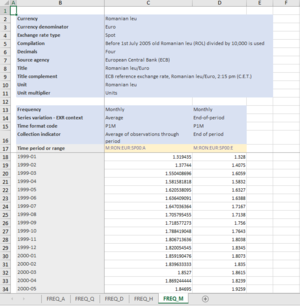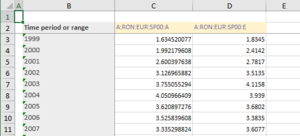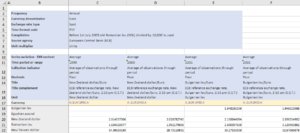Fusion-Excel-Series
Overview
The Fusion-Excel-Series format is not an official SDMX format. It has a similar layout to the Fusion-CSV-Series format, in that a Series is output per Column. The series can iterate values over time, or any other designated dimension to be at the observation level.
The advantages over CSV is that Excel provides a few additional features which are now possible in CSV, these are:
- The ability to slice the data over a Dimension to output a worksheet per Dimension value, e.g slice by FREQ would output Annual Data in one worksheet, Monthly data in another, and so on.
- The ability to promote fixed values to a header. Similar to the Fusion_Excel_Data format, reported values which are the same for the whole worksheet can be reported once in a header section
- Excel's freeze pane feature is used to make the inner table scrollable while keeping the column and row headers in place
- The use of colour to style the output, making the data easier to read
Fusion-Excel-Series is an export format only, supported by Fusion Registry, Fusion Edge Server and Fusion Data Browser.
Fusion-Excel-Series became available from Fusion Registry v10.4.5 onwards
Formatting Using Query Parameters
The following URL parameters can be used in a RESTful query for to get data in Excel format.
| Query Parameter | Values | Description |
|---|---|---|
| format | excel-series | Required to output the dataset in fusion-excel-series format |
| dimensionAtObservation | [dimension id] default TIME_PEREIOD for time series data |
Defines which dimension is iterated over on the rows |
| slice | [dimension id] default to N/A |
If provided, an Excel worksheet will be created for each distinct value in the dataset for this Dimension |
| labels | id or name or both (id is default) |
Output Ids or the corresponding name, or id and name |
| header | exclude (include is default) |
The header refers to the breakdown of Dimension values that sits above each series column. If excluded each column header is simply the series key. |
| fixed | keep or promote or remove (keep is default) |
Describes how to handle Dimension values which are the same for the whole dataset.
|
Note: The same formatting can be applied using HTTP Accept Headers as opposed to using REST query parameters.


